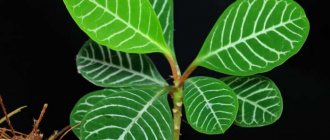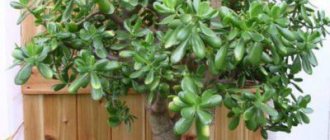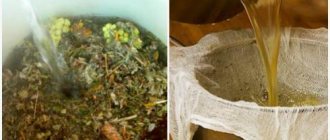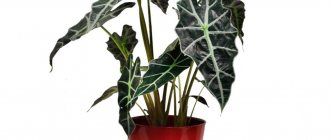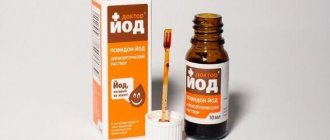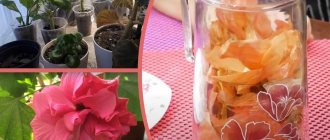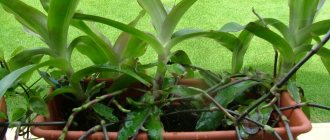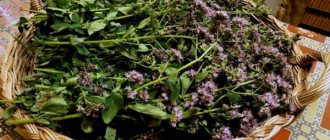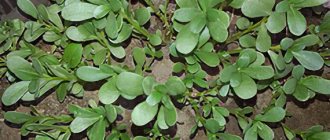What types are medicinal?
Only one variety of alocasia, called Alokasia macrorhiza, is classified as medicinal . It contains the lowest concentration of toxic substances, and its roots are even eaten in some countries. This plant is recognized by its tuberous root, similar to the fleshy ginseng tuber. The healing properties of large-rooted alocasia are not inferior to such well-known medicinal plants as golden mustache, eucalyptus and calamus root.
Chemical composition
In the official lists of medicinal plants, alocasia is listed only in some countries, where it is found in nature, and in general its chemical composition has not been sufficiently studied. It is known that all parts of this plant contain toxic substances - sublimate, mercury and hydrocyanic acid.
The healing properties of alocasia are due to the content of a number of biologically active substances in it, such as:
- flavonoids (quercetin, hyperoside, lycuroside);
- coumarins;
- alkaloids, one of which resembles quinine in composition.
It also contains:
- saponins;
- cardiac glycosides;
- tannins and anthracene derivatives.
Benefit
The benefits of the plant are due to its unique chemical composition. It contains:
- flavonoids;
- coumarins;
- alkaloids;
- tannins;
- saponins;
- cardiac glycosides.
Arma strengthens the immune system, tincture from it is used for rheumatism, thrombophlebitis, and some skin diseases, in particular there are recipes for the treatment of psoriasis.
It has found application in the fight against hemorrhoids, allergies, gout, tuberculosis, and mastopathy.
In Chinese medicine, Alocasia is used to relieve toothache. There it is actively used to treat cancer tumors.
Attention! Recipes from the plant are not used instead of treatment prescribed by the attending physician, but only together with the main course.
For medicinal purposes, they take leaves that already have a tendency to die. To prevent fresh juice from getting on your hands, cut the leaves while wearing gloves. This requirement also applies to the processing of raw materials.
Attention! Fresh Alocasia is not used for medicinal recipes; alcohol tinctures, compresses, and ointments are made from it.
What effect does the flower have?
Scientists have found that in addition to potent poisons, the plant contains many biologically active substances that have powerful anti-inflammatory, antimicrobial and expectorant effects . In addition, alocasia juice affects the immune system and the human body as a whole, activating its defenses and stimulating the functioning of the hormonal system.
In folk medicine, alocasia is used to treat:
- diseases of the musculoskeletal system - arthritis, rheumatism, myositis, osteochondrosis, herniated disc, gout, osteoarthritis, etc.;
- skin diseases - psoriasis, rashes of various origins, including allergic origin;
- varicose veins and thrombophlebitis;
- fibroids, fibromas and other benign neoplasms;
- tuberculosis;
- malignant tumors.
Contraindications, possible harm
Kidney disease, liver disease and hemophilia require complete cessation of the oral use of alocasia-based products. The plant should not be used as a medicine even with minor manifestations of allergies. The use of alocasia preparations by children, as well as pregnant and lactating women, is not allowed.
Before taking Alocasia medicine internally, you should consult your doctor .
If during treatment there are side effects similar to signs of poisoning - weakness, vomiting, dizziness, upset stomach - you should immediately stop taking the drug and seek medical help.
Planting, transplanting, propagation
Alocasia is replanted in ideal conditions once every 4 months. Actions depend on whether the bush will be divided or not. If it is necessary to divide the plant, clear the rhizome from the soil. If the goal is a simple transplant, the earthen lump is not removed.
You can propagate this tropical beauty:
- rhizome (looks like a tuber);
- cuttings;
- seeds.
Planting of seeds is carried out in the spring in sand with peat, deepening it to 1 cm. Then the crops are watered and covered with film, creating a greenhouse effect. After 18-22 days, shoots appear. Small sprouts are planted in separate containers. The usual decorative leaves can only be seen on one-year-old plants.
Field of application in medicine
Despite the content of toxic substances in its composition, and perhaps because of them, Alocasia large-rooted (Arma) has traditionally been used in Chinese medicine to treat cancer . The anticancer potential of arma, or rather its water infusion, was carefully studied at the University of Sichuan Province, where it was confirmed that it inhibits the growth of hepatoma.
Along with this, the Russian All-Union Scientific Research Institute of Medicinal Plants discovered the analgesic effect of 40% alcohol tincture of alocasia, obtained when applied externally in the treatment of osteochondrosis, myositis, pain in the joints and restoration of their mobility.
Amazingly, this highly poisonous plant has also been recommended for the treatment of miasmatic poisoning.
It should be noted that in the traditional medicine of our country, the properties of alocasia have not found much use. Using medicinal products from the plant without proper knowledge can be life-threatening . Therefore, information about the benefits of the plant is given not as a guide to action, but as information about the greatness and capabilities of nature.
The medicinal properties of arma can be used in precise dosage, under the guidance of a specialist and with the approval of the attending physician. Products for external use must be pre-tested by trial application to a small area of skin. An experienced healer selects the dose of alocasia for the treatment of a particular person individually.
Antitumor medicinal properties of alocasia
In Russia, scientific research has been and is being carried out to study external treatment with alocasia tincture or an ointment prepared on its basis. The results are positive. The Buryat herbalist Badmaev also confirms the positive medicinal effect of the tincture.
In 2012, the antitumor medicinal properties of alocasia on hepatocellular carcinoma were studied in China, where it was finally established that alocasia large-root kills cancer cells in the liver. Official medicine has recognized this drug as useful specifically for the treatment of liver cancer.
The drug is taken under the strict supervision of doctors. Suffice it to say, treatment begins with one drop of tincture diluted in a tablespoon of water, and increases every day by only one drop, and then decreases in the same order. The two-month course can be repeated only after a long break. The scheme was developed and applied by healer L. Kim.
The drug Alocasia for cancer is used under the strict supervision of doctors and exceeding the dose is unacceptable. When using the tincture, you need to take into account its complex effect on all organs.
Folk remedies and methods of treatment
Tincture
To prepare it, you need one of the lowest leaves of alocasia along with the petiole.
- It is crushed.
- Pour in 500 ml of 40% alcohol.
- Leave to infuse in a dark place for 2-3 weeks.
The finished tincture is filtered and used for external and internal use. internally to treat fibroids, tuberculosis, various neoplasms and joint diseases .
- Use the tincture starting with 2 drops per 1 tablespoon of water 2 times a day 20-30 minutes before meals.
- Add 1 drop of tincture daily, increasing the amount of water accordingly. When reaching 15 drops, the amount of water should be 1/4 cup.
- Gradually, the volume of the medicine is increased to 25 drops at a time.
- Then they also begin to reduce the dosage, 1 drop per day.
After completing the course of therapy, you need to take a break for 2-3 months, and then repeat the course from the beginning. For the treatment of severe diseases and malignant neoplasms, it is recommended to take at least 3-4 courses.
Attention! Do not exceed the dose! The plant is poisonous!
For external use, alcohol tincture is needed:
- Dilute with water in a 1:1 ratio.
- Apply a cotton napkin soaked in this composition to the sore joint or areas of skin disease for 30-40 minutes.
- Repeat the procedure for 7-10 days.
To treat varicose veins, apply a compress daily before bed for 2-3 months in a row.
Also, alcohol tincture of alocasia can be used to relieve itching from insect bites.
Water infusion
- Carefully cut and chop the bottom leaf of the alocasia.
- Pour a glass of boiled water at a temperature of 80-90 ºС.
- Leave for 8 hours in a cool place.
Store in the refrigerator for no more than 2 days. This infusion is used for rinsing, compresses and lotions .
Leaf pulp
The bottom leaf of the trefoil is ground in a meat grinder to a mushy state. The resulting pulp is applied to sore spots for joint pain . To treat skin diseases, the leaf is crushed with a knife so that a minimum of juice is released.
Oil
- Chop the leaf along with the stem.
- Pour 5 tablespoons of warm linseed or olive oil into a dark glass bowl.
- Keep in the refrigerator for 2 weeks.
- Filter thoroughly and pour into the same container.
The resulting oil is good for 3 months. The product is used for rubbing into the skin or as compresses for joint and rheumatic pain .
Ointment
- Take 3 parts of fatty cream or fat.
- Add 1 part of large-rooted alocasia juice.
- To stir thoroughly.
Store the product in the refrigerator for up to 1 week. The ointment is used to treat joint diseases and trophic ulcers .
Hood
- Grind the bottom leaf and stem of the alocasia.
- Pour a bottle of vodka and close tightly.
- Infuse for 2 weeks at room temperature in a dark place.
The extract is used in the form of compresses:
- To the area of the thyroid gland. The product is applied to gauze folded in four and the compress is kept for about three hours. The procedure is carried out daily for 2 weeks. After a four-day break, the course can be repeated.
- For the treatment of fibrocystic mastopathy, the same compress is kept for up to 6 hours. After 3 procedures, the pain disappears, the tumor breaks up into smaller fractions, which then resolve.
- To treat thrombophlebitis, a compress from the extract is applied to the affected veins and left overnight. The procedure is repeated for 7 days, then a break is taken for 3 days, and a weekly treatment is carried out again. After a month, the course can be repeated.
Root
Alocasia rhizome is crushed and applied to tumors of various origins .
Treatment
Rheumatoid arthritis
- Finely chop the lower leaf of the plant along with the stem.
- Pour 100 ml of 96% alcohol.
- Infuse for 10 days.
Rub the resulting tincture on sore areas at night.
Liver cirrhosis
- Finely chop the leaf along with the petiole (about 100 g).
- Pour a bottle of vodka.
- Stir and place in a warm place for 7-10 days.
- Keep the finished composition tightly sealed in a dark place at room temperature. Do not remove raw materials.
The treatment is long-term. Dilute 1 tablespoon of tincture in 100 ml of water and drink in the morning on an empty stomach half an hour before meals.
Joints
- Take ficus and alocasia leaves in equal parts (1:1) and make a paste out of them.
- Combine 4 parts of the resulting mixture with 6 parts of internal fat.
- Keep refrigerated.
Use for polyarthritis, rheumatism, rub into joints. For severe pain, baths of alocasia leaves (2 leaves per 2 liters of boiling water) will help, leave for an hour, dilute with water 1:8.
Sore feet
Rubbing with an alcohol tincture from a fresh plant helps a lot (1 leaf for half a liter of alcohol). The product is also indicated for the treatment of rheumatism, radiculitis, has a resolving effect on bruises and is an excellent wound healer.
Asthma
- Pour 50 g of dry crushed alocasia leaves into a bottle of vodka.
- Infuse in a dark place, shaking the contents periodically.
- After three weeks, strain the tincture.
Severe forms of bronchial asthma are treated by taking 1 tablespoon of tincture daily with water. Take 2-3 times a day before meals. As an additional remedy, it is recommended to drink a decoction of raspberry leaves instead of tea. The course of treatment is no more than 15-20 days.
It has also been noted that products made from the leaves and stems of alocasia are effective against pneumonia and tuberculosis .
Plant care
For all its exoticism, the bush is completely unpretentious and does not require care with complex manipulations. The main thing is that everything is done regularly and on time. It is advisable to keep it in a climate close to its native one, that is, it should be warm and humid.
In such an environment, the flower will delight you with its beauty. It may be that the leaves turn yellow and fall off. If this happens one leaf at a time, then it’s okay. New ones grow in place of fallen ones.
Lighting
The plant loves light, but the hot summer rays of the sun do not have a very good effect on it, so it is worth hiding the plant from direct exposure to the rays. And sometimes home care for alocasia in winter involves providing additional lighting.
Temperature
The Amazon and copper-red varieties suffer without additional light. The air temperature should be stable in summer 20 and in winter 18, changes and drafts are bad.
Watering
The soil of the flower should always be moist in the summer, but in winter it is necessary to moderate watering to prevent rotting of the roots. The alocasia plant needs additional nutrition; it needs to be fed at intervals of 14-20 days; ready-made nutrient mixtures for flowers growing at home are suitable.
Plant propagation
The flower can be propagated by division, cuttings, daughter bushes and seeds. But some species, when propagated by seeds, lose their decorative properties; this must be taken into account. The easiest way is propagation using daughter bushes or emerging sprouts.
Diseases and pests
When keeping the plant in a dry and hot room, alocasia pests such as spider mites, mealybugs, scale insects and aphids may appear. If the disease is detected immediately, washing the leaves with soapy water or, in advanced stages, an Actellik solution or something similar will help.
Alocasia is an excellent ornamental plant with medicinal properties. If you want to acquire an exotic plant, you must be careful and know everything about your home plant.
We recommend watching a video on caring for alocasia at home.
